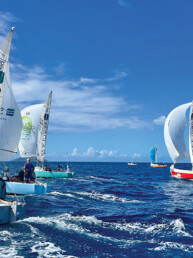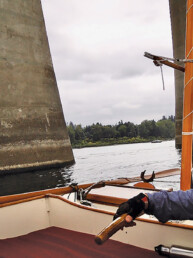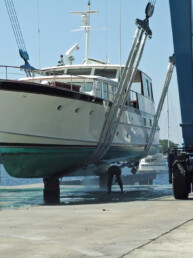Spare parts for different types of cruising adventures
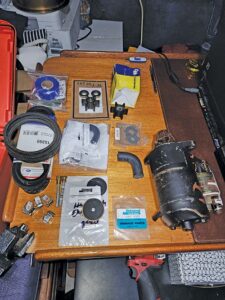
The day has come to untie those dock lines and head out on the water. As you motor out of your slip, the last things you want to think about are repairs, spare parts, or what could go wrong. But things do happen and it’s in the best interest of the boat and crew to be as prepared as possible — carrying engine spares is a big part of that preparation.
There is a long list of spares we could choose to carry. Still, when I am helping out folks on the water, they often don’t actually have what they need. It is important to prepare for the type of cruising you’re planning to do, so you have the right tools and parts while you’re away from the dock. Knowing how to install these items with the correct tools is also critical, since a mechanic is seldom nearby; or if there is one, you aren’t forking out “vacation” prices for a simple service.
Preparation does begin long before you are underway. While oddball things can fail, an engine that receives proper maintenance and an annual inspection should avoid most issues. Many things that fail are due to neglect, not random failure. But if you want to enjoy the wonders of cruising in the Pacific Northwest, it means declaring your preparations complete and heading out — hopefully with the appropriate redundancies and resources.
The following recommendations about spare parts and tools are cumulative, so be sure to include the suggestions for shorter cruises even if you are cruising longer distances. Starting with a focus on near-coastal and inland cruising, here is what I recommend having aboard when you leave the dock.
LOCAL CRUISING (10 miles or less)
Many folks choose to do short runs, whether it’s a day trip or an overnighter for the weekend. Being close to home does not mean you’re immune from running into trouble. While a very basic list, these issues are the most common that I come across when people call me with spring or summer emergencies. Assuming your engine is reasonably maintained as far as hoses and general servicing goes, having this minimum amount of spares will, in most cases, enable you to limp your boat home without a tow.
Enough engine oil and one filter for a complete oil change, and reverse gear oil
Rigid external oil lines can and will break from rust or chafe, if not inspected or maintained. I have also seen a few oil plugs/oil pressure sending units literally blow out. The typical result is that all the oil is lost in a matter of seconds.
It goes without saying that you cannot run your engine in that condition. Hopefully, you will be able to plug the hole to get them home, but in order to do so you must have spare oil on hand.
At least one primary and one secondary fuel filter
Especially if your boat has been sitting unused for a while, getting underway can stir-up algae and other crud in your fuel tank, mixing it with your diesel. As such, be prepared with one complete set of replacement fuel filters for whatever filter-set you’ve already got. Having more than one of each is better, especially if the tank is dirty. Changing filters usually requires bleeding the fuel lines for the engine to run smoothly again, so there’s also a key skill that comes with these physical replacements.
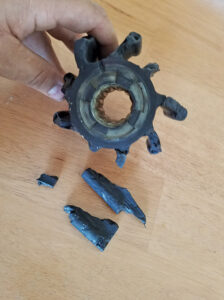
Raw water pump impeller and gasket
Nothing stops the fun faster than no water coming from your exhaust. A failed impeller is easy to fix, as long as you have a replacement that fits your engine with you.
At least one of each type of belt that the engine may have
Belts often go neglected and tend to break when used for the first time in a season. Also, it’s important to know how to change your belts and how much tension they should have.
SEMI-DISTANCE CRUISING (10-200 miles)
For longer trips up to and beyond the San Juan and Gulf islands, it is important to bring a few more items. These beautiful places often bring you farther away from easily accessible parts and services, but not so far that you will be completely on your own when it comes to repairing the basics on your engine.
I tend to plan routes in such a way that I have checkpoints along the way to my destination. Though I know of various places to stop and buy or order parts if I need to, it’s best to have the basics covered, including tools to remove and install these things if I am at anchor with no one close by. Towing is truly a last resort, and waiting for parts at marinas far from your homeport is expensive.
The items below are things I actually carry while cruising north each summer. Most of the larger maintenance items such as injectors, hoses, and exhaust elbows have hopefully been usually replaced throughout the year so they are not a problem while underway.
Enough coolant for a complete change, along with spare pre-bent hoses and clamps
It is easy to find wire-reinforced or rubber hoses in many places around Puget Sound, but not so easy to find engine specific pre-bent cooling hoses, because most places do not stock these and will have to special order them. If a pinhole in the heat exchanger forms, you will likely need to replace coolant more often until the heat exchanger can be replaced. Additionally, hoses that have been on the engine for a long time will most likely be damaged in the process of removing them, so it’s handy to have these ready to go when taking on this project.
If equipped, carry spare glow plugs and a glow plug relay
Faulty glow plugs can leave you stranded at random, inconvenient, or even dangerous times. Those of you with Universals, Westerbekes and more modern Yanmars will have glow plugs. Some of us will have a relay, and those are notorious for random failures. Carrying a butane heat gun can help diagnose this too and even get you started if you don’t have a relay on hand. My Universal diesel engine had this problem last summer and I had to use my torch for a few starts until I had the time to replace the relay at the dock.
Spare engine fuses and breakers, if equipped
Universal, Westerbeke, Kubota, and Nanni tend to use breaker-style circuit protection that is mounted on the back side of the engine. Carry an extra if your engine has one. If you have a starting battery fuse or breaker, it is also a smart idea to carry a spare.
Spare raw water pump and/or a rebuild kit
Don’t get stuck with a leaking raw water pump. While this is not a critical issue, a leaking pump can lead to further problems if you’re cruising for several weeks. Having a rebuild kit or a spare pump handy can save you problems later. If you’re using a rebuild kit, remember you will need a gear puller and a vice to pull the drive gear in some cases, and a vice to press the shaft out.
Starter
Starters can randomly fail and, while some engines have a hand crank, most don’t actually have enough access to use the handle. I have a used spare that is functional so I can slap it on and go.
Propeller
An ill-maintained prop can definitely fail under load. Also, a good hit with a log or other obstruction can also take out a blade or the whole prop. While you may be able to limp into a marina, it sure is nice to have the spare on hand so you don’t have to search and wait for one while at a guest slip.
What cruiser doesn’t love the freedom of being away from the dock? It’s the feeling we live for! Whether in the islands or closer to home, these adventures require elements of self-sufficiency. Having some essential spares for your engine, and the tools and know-how to employ them is a central aspect of nautical self-reliance. The list of spares above should ably cover Salish Sea cruising. If you’re headed to much more remote areas, including offshore, the parts list and skill set becomes more extensive — which I’ll discuss in my next column. With routine maintenance at home and few parts and skills, you’ll be able to focus on the fun of cruising knowing you’ve given yourself a simple safety net.
Meredith Anderson is the owner of Meredith’s Marine Services, where she operates a mobile mechanic service and teaches hands-on marine diesel classes to groups and in private classes aboard their own vessels.


